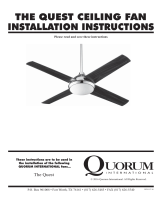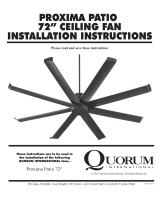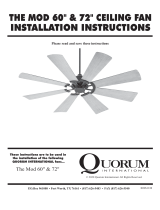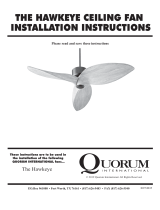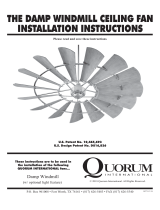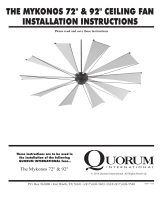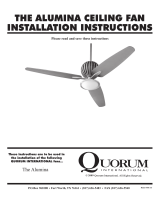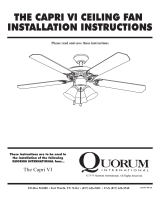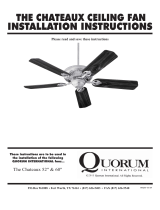Page is loading ...

Please read and save these instructions
© 2016 Quorum International. All Rights reserved.
P.O.Box 961008 Fort Worth, TX 76161 (817) 626-5483 FAX (817) 626-5540
IO232-02/16
THE HOLT CEILING FAN
INSTALLATION INSTRUCTIONS
The Holt

This warranty gives you specific legal
rights, and you may also have other rights
which vary from state to state.
WHAT IS COVERED-
Except as specified below, the manufacturer
of this product warrants it to be free of all
defects in workmanship and material.
WHAT IS NOT COVERED BY THIS
WARRANTY-
1. All costs of removal or reinstallation
of the fan.
2. Damage resulting from failure to
follow instructions contained herein.
3. Damage occurring during shipment of
the product (claims must be presented to
the carrier).
4. Damage resulting from accident,
misuse, abuse, or neglect.
5. Damage resulting from the application
of any exterior coating, or by the addition
of any unapproved accessories.
6. Damage resulting from repair or
attempted repair by anyone other than the
manufacturer.
7. Damage resulting from causes other
than product defects, including lack of
1. Most problems can be handled by our
customer service agents over the
telephone. Customers seeking warranty
repair or replacement for any fan or
component are encouraged to call us for
assistance. All returns must be issued a
Return Goods Authorization number
(RGA) prior to returning the defective
unit or part. Call (817) 626-5483 -
Monday thru Friday 8:00 a.m. - 5:00 p.m.
CST to obtain a RGA number.
2. Arriving shipments will be refused if
they do not bear a valid RGA number on
the outside packaging.
3. A dated proof of purchase must
accompany any fan or component clearly
indicating the name of the original
purchaser.
4. To avoid damage in transit, the
product should be returned in its original
box and packaging. Quorum will not bear
responsibility for any shipping damage.
5. Any return of a fan or component
must be shipped freight and insurance
prepaid.
Complete and mail the enclosed
warranty card within 10 days to ensure
your warranty is registered.
If you have any questions regarding the
warranty, or the procedures for
obtaining service, please call us at
(817) 626-5483 - Monday thru Friday
8:00 a.m. - 5:00 p.m. CST.
technical skill, competence, or experience
of the user.
8. Glass or acrylic components or
accessories.
9. Minor occurrences of wobble are
accepted as normal and should not
necessarily be considered a defect.
WHO MAY ENFORCE WARRANTY-
This warranty may be enforced only by
the original purchaser. The end user must
possess a dated proof of purchase from an
authorized Quorum dealer to establish a
warranty claim.
LENGTH OF THE WARRANTY -
1. For the fan motor - for the lifetime of
the original purchaser.
2. For everything else, except blades and
finish - one year from the date of
purchase.
3. For fan blades and finish - 90 days
from the date pf purchase.
WHAT WE WILL PAY FOR -
We agree to correct defects outlined in the
warranty without charge, or at our option
replace the fan with an equivalent or
superior product if the defective unit is
returned prepaid to us.
TO GET WARRANTY SERVICE -
To obtain warranty service, the product
must be returned prepaid to Quorum.
(This warranty is not enforceable outside
the United States.) Details regarding
return shipment are explained elsewhere
in this manual. Whenever warranty
service is required, you must present a
copy of the original dated sales receipt as
proof of coverage.
There is no other express warranty.
Quorum hereby disclaims any and all
implied warranties, including but not
limited to those of merchantability of
fitness for a particular purpose to the
extent permitted by law. Quorum shall
not be liable for incidental,
consequential, or special damages
arising out of or in connection with the
product use or performance except as
may otherwise be accorded by law. The
duration of any implied warranty which
cannot be disclaimed is limited to the
periods specified above in the express
warranty.
QUORUM'S UNIQUE LIMITED
LIFETIME WARRANTY
WARRANTY SERVICE
FOR YOUR RECORDS
Purchased From
City State
Fan Model No.
Date Purchased

Unpack your fan and check the contents. Do not discard the carton. If warranty
replacement or repair is ever necessary the fan should be returned in original packaging.
Remove all parts and hardware. Do not lay motor housing on its side - because the
decorative casing may shift. Check all visible screws, bolts and nuts for tightness.
Examine all parts. The following parts should be included:
2. UNPACKING YOUR FAN
NOTE:
Some Quorum fan models will have slightly
different parts than what is shown here
depending upon the design you have chosen.
Basic installation procedures are similar for
all models.
IF YOU FIND THAT PARTS ARE MISSING. CONTACT YOUR DEALER FOR REPLACEMENT, OR CALL QUORUM DIRECTLY AND WE WILL MAIL REPLACEMENTS TO YOU IMMEDIATELY.
l.
1. SAFETY RULES
Model #66565-xx: 17 lbs
1. To avoid possible electric shock, turn
off the electricity at the main fuse box or
circuit panel before you begin the fan
installation or before servicing the fan or
installing accessories.
2. Read all instructions and safety
information carefully before installing
your fan and save these instructions.
3. Make sure all electrical connections
comply with local codes or ordinances as
well as the National Electrical Code. If
you are unfamiliar with electric wiring,
please use a qualified and licensed
electrician.
4. Make sure you have a location
selected for your fan which allows clear
space for the blades to rotate, and at lease
seven (7) feet of clearance between the
floor and the fan blade tips.
5. The outlet box and ceiling support
joist used must be securely mounted, and
capable of supporting at least 50 pounds.
To reduce the risk of fire, electric shock,
or personal injury, use only an outlet box
clearly labeled "Acceptable For Fan
Support".
6. To reduce the risk of personal injury
use only approved hanging brackets and
screws supplied with the outlet box for
mounting to the outlet box.
7. After installation is complete, check
that all connections are absolutely secure.
8. Do not insert anything into the fan
blades while they are rotating.
9. To operate the reverse function on the
fan, press the reverse button on the wall
transmitter while the fan is running.
1. Set of 5 blades (a)
2. Hanging bracket (b)
3. Canopy (c)
4. Downrod assembly (4.5") (d)
5. Yoke cover (e)
6. Fan motor assembly (f)
7. Light plate (g)
8. LED assembly (h)
9. LED diffuser (i)
10. Wall transmitter incl. mounting screws and wire nuts (j)
11. Blade balancing kit (k)
12. Canopy receiver (l)
13. Parts bags (m) containing:
Blade attachment hardware
(Screws/lock washers, washers may be
attached to screws)
Mounting hardware (wire nuts, wood
screws, machine screws, lock washers,
spring washers, metal washers.)
b.
c.
d.
e.
f.
k.
g.
i.
j.
m.
10. Do not attempt to control the
operation of the fan (or an optional light
kit) from any wall control that is not
approved by Quorum for use with its fans.
Do not use solid state wall controls. The
use of any unapproved control voids the
fan's warranty.
11. Federal regulations require all ceiling
fans with light kits manufactured or
imported after January 1, 2009, to limit
total wattage consumed by the light kit to
190W. Therefore, this fan is equipped
with a wattage limiting device.
TOOLS REQUIRED
FOR INSTALLAITON
Phillips Screwdriver
Wire Cutters
Electrical Tape
Step Ladder
a.
h.

1. Disconnect the power by removing fuses
or turning off circuit breakers.
2. If there is an existing outlet box, ensure it
is clearly marked "Suitable for Fan Support".
If it is not so marked, it must be replaced
with an approved one.
3. Secure the outlet box (or make sure the
existing box is secured) directly to the
building structure. Use appropriate fasteners
and building materials.
4. Figures 1,2 and 3 are examples of
different ways to mount the outlet box in
different situations. A longer downrod may
be required in sloped ceiling situations to
maintain proper blade clearance.
5. To hang the fan in locations where no
ceiling joist is available, a hanger support bar
may be required (Figure 4). Quorum
distributes approved hanger support bars and
outlet boxes.
3. MOUNTING OPTIONS
WARNING: TO REDUCE THE RISK OF ELECTRIC SHOCK, FIRE, OR PERSONAL INJURY,
MOUNT THE FAN ONLY TO AN OUTLET MARKED ACCEPTABLE FOR FAN SUPPORT AND USE
MOUNTING SCREWS PROVIDED WITH THE OUTLET BOX.
CAUTION: TO REDUCE THE RISK OF PERSONAL INJURY, INSTALL THE PRIMARY MOUNTING MEANS AND USE ONLY THE HARDWARE
PROVIDED WITH THE FAN.
2 .giF1 .giF
4 .giF3 .giF
Ceiling Joists
Ceiling Joists
Ceiling Joists
Ceiling Joist
Hanger
Support Bar
Ceiling Joist
Outlet Boxes
Recessed
outlet Boxes
Outlet Boxes
Outlet Boxes
Angled ceiling
maximum
20º angle
(with 4"
downrod)

4. HANGING YOUR FAN
WARNING -
Turn off the power!
DO NOT fasten the blades to the fan until it is
assembled and hanging from the ceiling.
1. If not already affixed to the hanger
bracket, place the rectangular rubber isolators
between the hanger bracket and outlet box.
Secure the hanger bracket to the outlet box
using the 2 long steel screws supplied with
the outlex box. (Fig. 5)
2. Remove the set pin and safety lock clip
from the yoke on top of the motor assembly
(Fig. 6a). Slide the downrod through the
canopy and canopy cover. Slide the yoke
cover onto the downrod (Fig. 6b).
Feed the wires from the fan motor through
the downrod assembly.
3. (Fig. 7) Attach the downrod assembly
(downrod, yoke cover and canopy) to the
motor by sliding the downrod into the yoke
on top of the motor assembly. Slide the
set pin through the hole in the yoke, downrod
and secure it with the safety lock clip. Tighten
the screws on the yoke. The yoke cover will
lower down to conceal the yoke. Feed
the wires through the downrod ball.
4. Lift the fan motor without the blades and
place into the hanger bracket, rotating the
ball until the groove engages the tab on the
hanger bracket. This locks the ball mount
and fan motor, preventing fan rotation during
operation. (Fig. 8.)
Outlet box
(j-box)
Hanger bracket
Safety
Lock Clip
Motor
housing
Safety
Lock Clip
Set pin
Set pin
Set screw
Washer
Washer
Downrod
assembly
Downrod
assembly
Downrod
Yoke
Yoke cover
Yoke
cover
Washers
Outlet box
screw
Downrod
Hanger
bracket
Fig. 8Fig. 5
Fig. 6a
Fig. 6b
Fig. 7
Ceiling
canopy

5. ELECTRICAL CONNECTIONS
1. SAFETY PRECAUTIONS
• Disconnect electric power source by removing fuse or
switching OFF circuit breaker.
• Do not use with solid state fans.
• Electrical wiring must meet all local and national electrical code requirements.
• Electrical source and fan must be 115/120 vold, 60Hz.
• Maximum fan motor 40W. Maximum light watts; 60W LED only.
2. CONNECTING THE RECEIVER (Fig. 9a & 9b)
Use the wire nuts provided and make eletrical connections as follows:
• Connect Green wire from fan to the bare copper (ground) from the
junction box.
• Connect Black wire (AC IN L) from the receiver to the Black
wire from the junction box.
• Connect White wire (AC IN N) from the receiver to the White
wire from the junction box.
• Connect Red wire (MOTOR 1) from the receiver to the Red wire
from fan.
• Connect Purple wire (MOTOR 2) from the receiver to the Purple
wire from fan.
• Connect Grey wire (MOTOR 3) from the receiver to the Grey
wire from fan.
• Connect the Blue wire (FOR LIGHT) from the receiver to the Blue
wire from fan.
• Connect White wire (FOR LIGHT) from the receiver to the White
wire from fan.
• After wires are connected, carefully tuck them into the juction box.
• Lay the Black antenna wire on top of the receiver and insert into
the mounting bracket.
3. INSTALLING THE BATTERY
• Remove the small panel on the front of the transmitter and
insert the battery provided and install provided.
NOTE: Use 12V (23A) battery. If control is not being used for
an extended length of time, remove the battery to prevent
possible damage to transmitter (See Fig. 10)
4. INSTALLING THE WIRELESS TRANSMITTER
• Remove the existing wall plate and switch. Be sure to complete the
electrical circuit within the junction box by-passing the wall control.
Connect Black to Black, White to White and Green to Green.
Carefully push wires into junction box.
• Attach wall control unit to the juction box using the two #8-32
screws provided.
• Attach the wall plate to the switch control face using the two small
screws provided (Fig. 10)
5. SETTING THE FREQUENCY
• With the power OFF to your ceiling fan, use a small tool to set the
frequency in the wall transmitter (Fig. 11). Note at least one of the
switches 1-4 must be in the “ON” possition.
• Return power to the unit - NOTE; After AC power is restored, do
NOT press any other buttons on the wall transmitter before pressing
the “ON/OFF” button for 10 seconds.
• Within 60 seconds of restoring AC power, press and hold the
transmitter’s “ON/OFF” button and “LIGHT” buttons for 5 seconds.
• Once the receiver detects the set frequency, the light of the fan (if
applicable) will blink twice (there is no indication if the fan does not
have a light).
• The receiver has now learned the selected frequency of the
transmitter. After completing the steps above, you should be able
to operate the ceiling fan (and light). If the fan is not responding to
the transmitter, turn power off to the unit and repeat the process.
Fig. 10
Fig. 11
Fig. 9b
Fig. 9a
WARNING! SHUT OFF THE POWER WITH FUSE OR CIRCUIT BREAKER.
Screws
Screws
Wall plate
#8-32 screws
Face
plate
Junction
box
Wireless
transmitter
Battery
slot
12V
M O T O R 1
m o t e u r 1
M O T O R 2
m o t e u r 2
M O T O R 3
m o t e u r 3
M O T O R 1
m o t e u r 1
M O T O R 2
m o t e u r 2
M O T O R 3
m o t e u r 3

6. COMPLETING THE INSTALLATION
1. Make sure the wiring is safely inside the
outlet box as instructed in Step 5 -
Electrical Connections. Install the
canopy by sliding up to hanger
bracket and place the key hole on the
canopy over the screw on the hanger
bracket, turn canopy until it locks in place
at the narrow section of the key holes (Fig 12).
Align the circular hole on canopy with the
remaining hole on the hanger bracket,
secure by tightening the two set screws.
Note: Adjust the canopy screws as necessary
until the canopy is snug (Fig. 12).
2. Blade Assembly & Installation
Attach the blade assembly to the motor
assembly using the supplied screws
and washers (Fig. 13).
3. Attach the LED kit
Prepare to attach the LED kit by removing
one of the three screws on the flange and
loosen the other two screws (Fig. 14a).
Attach the light plate to flange using the
screws just removed and loosened from
the flange (Fig. 14b).
Next remove three screws from outer edge of
light plate. These will be used to attach the
LED module (Fig. 15).
Connect the LED module by connecting the
black and white wires with the polarized wire
connectors (black to black and white to white)
(Fig. 16).
Attach LED module to the light plate using the
three screws previously removed (Fig. 17).
4. Installing the LED lens (Fig. 18)
Line the teeth inside the light plate with the
notches in the plastic lens. Insert lens
and turn clockwise to install.
Fig. 13
Fig. 12 Fig. 15
Fig. 14a
Fig. 16
Fig. 17
Canopy
Screws
Screws
Screws
Screws
Washers
Blade
Hanger
bracket
Loosened
screw
Flange
Light
plate
Motor
housing
Loosened
screw
Remove
screw
Fig. 14b Fig. 18
Polorized wire
connectors
Polorized
wire connectors
Light
plate
Light
plate
Light
plate
Light
plate
LED
module
LED
module
Plastic
lens
Tooth

7. OPERATING YOUR TRANSMITTER
1. WALL AND FACE PLATES
• This fan is supplied with two finish wall and face plates for the control -
White and Almond.
• Select finish plates and attach to the control after installing the battery
and setting the frequency. (Fig. 19)
2. OPERATING TRANSMITTER
• “SPEED+” button - Is used to select fan speed. Press and release the
button of desired speed setting (speeds 1 through 6). Press the button to
increase the fan’s speed. A buzzer will beep when pressing the button
and will beep twice when highest speed is reached.
• “SPEED --” button - Is used to select fan speed. Press and release the
button of desired speed setting (speeds 1 through 6). Press the button to
decrease the fan’s speed. A buzzer will beep when pressing the button
and will beep twice when lowest speed is reached.
• “FOR/REV” button - Is used to change the rotation direction of the fan.
• “ON/OFF” button - Is used to turn the fan on and off.
• “LIGHT” button - Is used to turn the light on, off or to control the
brightness of the light. If the fan has no light kit, simply ignore
the light button.
To work the light, press and release the button and the light will turn
on or off. Press and hold the button for the desired brightness. The light
will cycle continuously between bright and dim settings as long as the
button is held down. The light key has auto resume; it will stay the same
brightness as the last time the fan/light was turned off.
• Memory function - If the fan and/or light are turned offby the wall
control, it will memorize and recover automatically to the same fan
speed and light brightness as it was the last time the fan/light was
turned off.
• This remote control is equipped with 16 code combinations to prevent
possible interference from other remote units such as garage door openers,
car alarms or security systems. If the fan or light kit turns on or off without
using the control, simply change the combination code in your transmitter.
Fig. 19
12V
S P EED+
S P EED-
FO R /R EV
ON /OFF
LIGHTLIGHT
S P EED+
S P EED-
FO R /R EV
ON /OFF

1. A ceiling fan is an environmentally
smart choice to cool as well as to help
warm your home or office. Adjust your
HVAC thermostat during fan use to save
additional energy and money on your air
conditioning and heating utility bills. You
should see a significant reduction in both
your heating and cooling costs by regular
use of your fan.
Do not hesitate to use your fan during
summer and winter months. In summer,
(Fig. 20) using the reverse switch, adjust
the fan's direction so cool air is blown
down, producing a cooling breeze. In
winter, (Fig. 21) reverse the fan so that an
upward airflow will push warm air off the
ceiling and circulate it downwards into
the living area. In winter months, use the
fan at a lower speed than summer.
2. Periodically check tightness of all
screws securing the blades to the blade
arm attachment points. A clicking or a
rattling noise is a sure indication of
loosening screws. Since screws will
invariably work loose over time, at least
once a year, tighten all the screws
attaching blades to blade arms. Do not
bend blade arms when cleaning or
servicing the fan.
3. Clean you fan periodically using only
a cloth dampened with a mild detergent
solution for all hardware - never use
solvents. The finish plating is lacquered
to prevent tarnishing. Use a lint-free cloth
with clean water to clean blades.
4. You will never need to oil or lubricate
your fan. Its permanently sealed bearings
will provide trouble free, silent operation
for many years.
5. If repairs or servicing are ever
required, to avoid possible electric shock,
turn off the electricity at the main fuse
or circuit panel before you begin.
8. FAN OPERATION AND CARE
Fig. 21
Fig. 20

FAN WILL NOT START
1. Check that the electricity has been
turned on at the circuit breaker which had
probably been turned off during
installation.
2. T
3. Be sure ON/OFF power switch on the
wall control is in ON position.
urn off the electricity. Check all
connections in the wiring of the fan at the
ceiling and make sure it follows the
wiring instructions outlined in this
manual.
NOISE
Note: Always allow a day or two "run-in"
time for any new fan at medium or high
speed. When attempting to diagnose
noise, listen carefully from several sides
to try and isolate the location of the noise
(blade, upper end, motor, light kit, etc.)
1. Tighten all screws attaching blades to
blade arms. Remember to tighten these
screws at least once a year because they
may loosen slowly over time and cause a
clicking noise.
2. Turn off the power. Loosen the
canopy and check that the wiring and/or
wire nut connectors are not resting against
the canopy, possibly vibrating while the
fan is on.
3. Use of a standard light rheostat or an
unapproved fan wall control to control the
fan speed will always cause an annoying
"hum". Many fan motors do not work
quietly with solid state variable speed
controls.
4. Check that the rubber gasket on the
mounting bracket has been installed if
called for in the installation instructions.
5. Check that the canopy is not touching
the ceiling.
6. Check that all screws on the motor
housing and the bottom housing are tight.
FAN TURNS, BUT DOES NOT MOVE
MUCH AIR
1. The fan may be running in reverse.
Press the reverse button on transmitter to
set the fan in forward operation.
2. The distance from the ceiling to the
blades may be too small. For downrod
fans, optimal placement would be 8-9 feet
from the floor.
3. The room may contain items which
obstruct the air flow.
4. The fan may be too small for the size
of the room.
EXCESSIVE WOBBLE
Note: A small amount of wobble is
considered acceptable and should not be
considered a defect.
1. Make certain all blades are tightly
attached to each blades' respective blade
arm.
9. TROUBLESHOOTING
REPLACEMENT PARTS AVAILABLE
A full range of genuine replacement
spare parts are available at reasonable
cost directly form Quorum
International. Please call us at (817)
626-5483. Monday through Friday
from 8:00 A.M. to 5:00 P.M. CST.
/

